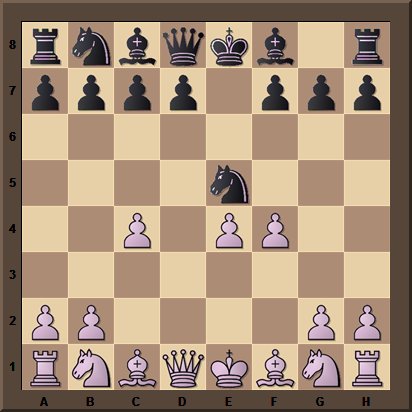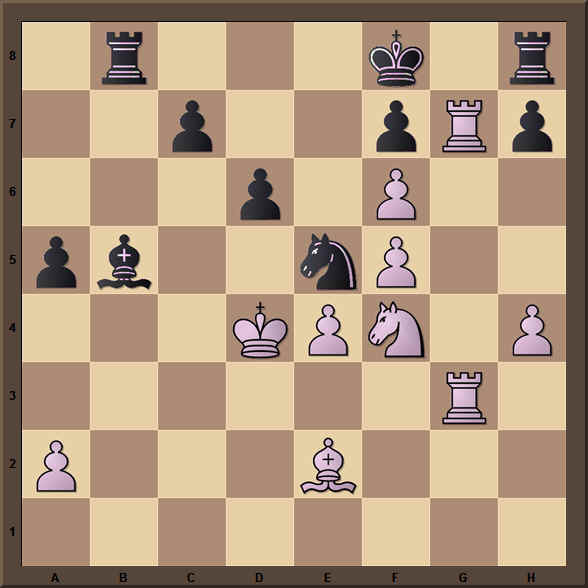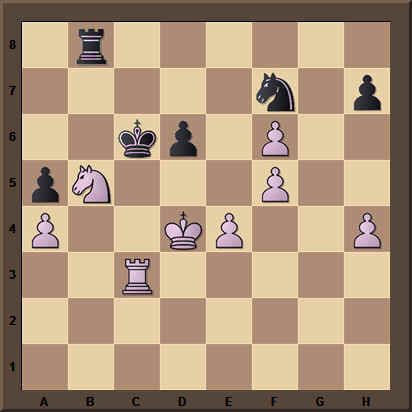All
the |
(Navigation bar
directly below.)
*******
© A.J. Goldsby, 2015.
(All rights reserved.)
****************
Click HERE
to see my
Chess Items.
****************
****************
Buy a book
from Amazon.com
(And help me out as well!)
****************
Click HERE
...
to see a list of the businesses that help to sponsor all of
my chess efforts.
CG
- "Problem of the Day"
(September 3rd, 2009.)
|
This is a game that I analyzed in 2009, however, it was never posted. (See - also - the last game that I posted, as well.) It was also around this period that I began a very stupid idea of selling chess books on eBay - working for/with an absolutely impossible person ... who was a real tyrant when in came to work-related matters. It almost killed me, and {in the end} he snatched the rug out from under me, (taking back all the merchandise - leaving me with orders that I had sold but now could not fill!); causing a huge (negative) impact on my financial status ... with ripples that that continues to this very day. Because the stupid eBay enterprise took almost all of my free time, I had very little of it to devote to my websites. For whatever reason, this game fell through the cracks, and I only recently rediscovered it. Since I may not have access to my main computer, at least for a while, I thought that I would go ahead and format it and get it ready for public consumption. (If you like it, please send me an e-mail and tell me.) I hope you enjoy my efforts. |
Click HERE to see an explanation of the symbols that I commonly use when I annotate any chess game.
Click HERE to replay this game ... on another server. Click HERE to see a PDF copy of my analysis.
Click HERE to see my YT video of this game.
NOTE: This was not a perfect game of chess, nor was it played between two Super-GM's. "So why annotate it?," you ask.
-
There are some VERY interesting tactics here!
-
Going over the game, I was curious about several moves, especially Ne6 at one point.
-
The opening is a Budapest Defense, and I have not annotated that many games in this particular opening system.
********************************************************************************************************************************************************
Before you write me an e-mail to tell me about what I missed in this game, let me just tell you that:
-
I do not consider this a definitive analysis!!! The game was too long for that, to do a really thorough job would take more effort
than I cared to expend. I just wanted to cover the important parts of the game, especially the tactics around move 37. -
At almost every turn, both players may have missed the best move, at least according to the computers. To provide a comment after
every single move ... plus a detailed analysis ... was not what I had in mind when I began this job of annotation.
Stanislav Savchenko (2485) -
Alexey Ivanov (2380)
|
|
|
[A.J. Goldsby I]
The "Chess Games" ... (http://www.chessgames.com) puzzle or problem for the day for Thursday; September 03rd, 2009.
White to play, (37. '?').
1.d4 Nf6; 2.c4 e5!?;
The Budapest Gambit. (Pretty wild, but maybe playable. [Click HERE to see a game where I played this opening.])
[ Please see MCO-15, beginning on page # 503 for more analysis of this whole opening. ]
[ The continuation of: 2...e6;
3.Nc3 Bb4; would lead to a Nimzo-Indian.
(Of course, many other moves were possible for Black on
move two,
leading to dozens of other possibilities.) ]
3.dxe5,
It is correct for White to capture here.
(By capturing, White forces the
Black Knight to move and lose time, other continuations are generally much
less
forceful and allow the second player to get a
fairly easy game.)
[ White can often get into trouble with the move 3.d4-d5.
For example:
</= 3.d5!? Bc5; 4.Bg5?
Ne4!?;
"+/"
Here White thought for some time ... and then resigned! (0-1)
John Laning - A.J. Goldsby
I; Home Training Game / 2009.
]
3...Ng4;
The standard move here for Black.
[ Black can also play:
3...Ne4!?; which is tricky, but ultimately ...
it may turn out to be unsound. (A51: Budapest, Fajarowicz var.
Again, see MCO-15 for more information on this system.) ]
4.e4, (Center, space, development.)
Rather than guard the Pawn, White allows Black to immediately recapture it.
However, in return, White generally gets a free and easy development.
[ The most commonly chosen path is:
4.Bf4 Nc6; 5.Nf3 Bb4+;
etc.
[See MCO-15 for more details.] ]
4...Nxe5; 5.f4!?,
White immediately kicks the Black Knight out of the center ...
|
|
rnbqkb1r/pppp1ppp/8/4n3/2P1PP2/8/PP4PP/RNBQKBNR b KQkq f3 0 5
However, one of the problems of this line is that White might find it difficult to cover the g1-a7 diagonal.
[ For some excellent analysis of this line, please see the new
book:
"The Fabulous Budapest
Gambit," by GM
Viktor Moskalenko. (Pg. # 120.)
]
[ Another way for White to proceed is to simply develop his pieces, ergo:
5.Nf3 Nbc6; 6.Be2
Bc5; 7.0-0 d6; 8.Nc3, "+/="
8...0-0;
"<=>"
when White has a good grip on the center.
(However, Black has good development, and he should not lose as
long as he does not play carelessly from this position.) ]
Black's next move is considered to be the second player's safest square for the attacked Knight@e5.
5...Nec6; 6.Nf3, (center, development)
This is a good variation for White, however, many players prefer to immediately grab the diagonal with Be3 here instead.
[ Another line for White was:
RR 6.Be3 Bb4+;
7.Nd2, The safest.
***********************************************
(White could also try:
7.Nc3!? Qh4+; 8.g3 Bxc3+;
9.bxc3 Qe7;
10.Bd3, "+/=" 10...Na6; '~' (unclear)
The authors of MCO rate this position
as equal, Fritz sees White as having a
small (but solid) edge.
Re. the game:
Paul Keres - Gilg / Prague, POL; 1937.
[ See MCO-15, page # 504;
column # 05,
and mainly note # (r.). ] )
***********************************************
7...Qe7; 8.Bd3
Na6; '~' (unclear)
but Black looks to have a relatively playable position here.
See the contest:
U. Schuster (2420) - D. Molzahn (2245); /
W-ch GT271 / ICCF correspondence / 1990.
{This game was eventually drawn.} ]
6...Bc5; 7.Nc3 a5!?; 8.Bd3 d6; 9.Qe2 Bg4;
This is one of the standard lines (here) for Black, but perhaps it is time for a re-appraisal of this whole variation.
(Maybe 9...0-0; instead?)
10.Be3 Nd4!?; (Maybe - '?!')
This looks to be too ambitious and is perhaps the cause of many/most of Black's troubles in this game.
[ Probably a little safer was: (>/=) RR 10...Nd7; 11.0-0 0-0; '~' (unclear) - Fritz 11. ]
11.Qf2 Nxf3+?!; (Maybe - '?')
This was/is a 'book' line here. Yet this capture only serves to strengthen White's center and it also loses time as well.
[ A little better was:
>/= 11...Ne6;
12.0-0 0-0; 13.Bxc5 Nxc5;
14.Rad1, "+/="
("Plus-over-equal" ... with an advantage for White.)
and although White is solidly better in this position,
Black's game looks to be fairly playable here. ]
12.gxf3 Bxe3; 13.Qxe3 Qh4+; 14.Kd2 Be6?;
A further loss of time, now Black's position begins to unravel.
[ Better was: >/=
14...Bd7T; (Box.) 15.Rag1
0-0; 16.Kc1 Na6; 17.Kb1, "+/="
(White is slightly better in this position.) ]
15.f5 Bd7; 16.Nd5 Kd8; (Hmmm.)
Perhaps another inaccuracy?
[ Maybe better was:
(>/=) 16...Na6;
17.Rag1 Bc6; 18.Rg4
Qh6; 19.Qxh6, '±'
('+/' White is clearly better here, maybe just "+/-")
and although Black's position is truly (much) worse,
I don't yet see a forced win for White. ]
Now on White's 18th and 19th turns, the move RxP/g7 won a Pawn ... (the computer prefers these lines).
17.Rag1 Bc6;
Something like this is best, Black had to let the g-pawn go. (see below)
[ Instead, after the continuation:
</= 17...g6?; 18.Rg4 Qh5;
19.Nf4, "+/-" (trapped Queen)
Black must give up the lady. (...QxR/f4)
[I.e., 19...Qh6?; 20.Ne6+, & wins.] ]
For the next series of moves, we have the brief summation of events: White continues to ignore the Pawn grab on g7 for another couple of moves. Meanwhile, Black gets his Queen to f6, when I would have been tempted to play quietly with Kc2, but White allows things to get opened up, the first player doubles Rooks on the g-file and only then does he capture the pawn on g7.
18.Rg4 Qh5; 19.Nf4!? Qh6; 20.Rhg1 Qf6; 21.Rxg7 Qxb2+; 22.Bc2!?,
This is OK, even good for White ...
[ Maybe better was:
(>/=) 22.Ke1! Rf8; 23.Qd2,
'±' ('+/') etc.
when White has penetrated on the g-file. (Fritz.) ]
After 22...Nd7; White has the very interesting sack of 23.Ne6+!
(The computer likes this and it may win by force for White, see the CG
web-page for this
game for lots of analysis of this move.
Click HERE to see my (picture/jpg)
analysis of
23.Ne6+, click HERE to see a short
YT video of this possibility.)
22...Nd7; 23.Qc3 Qxc3+; 24.Kxc3 Ke7; 25.h4 Ne5; 26.R1g3 Kf8; 27.Nh5 Ng6!?;
This is an attempt to trap White's Rook.
However, (in retrospect), it seems to be a bad idea, the computer's evaluations of the position
take a dramatic turn for the worse after 27...Ng6.
[ Probably better was: >/= 27...Nd7; - Fritz 11. ]
28.f4 Re8; 29.Kd4 b6; 30.f6 Bb7; 31.f5!?,
This advance, while tempting, may not have been the best.
[ The machine prefers:
>/= 31.Rg4 c5+; 32.Ke3 Bc6;
33.Bd3, "+/="
with an edge to White. ]
31...Ne5; 32.Nf4 Bc6!?; 33.Bd1! Rb8; (Hmmm.)
The computer's evaluations of the position nearly double after this move, maybe ...Rc8; (or 33...Bd7); was a little better.
[ Probably better was:
>/= 33...Rc8; (passive defence)
34.Ne6+ Ke8; 35.Bh5, "+/-"
and although Fritz shows that White is winning in this position,
a winning breakthrough is not readily apparent. ]
34.Bh5!?,
This is OK, even winning for White, but now it is apparent that White had a much more forceful variation at his disposal.
[ White missed an immediate
"cruncher" with the following line:
>/= 34.Ne6+!! Ke8T; This is forced.
( An inferior continuation was:
</= 34...fxe6?!; 35.fxe6 Ng6T;
36.Bh5 Ke8T; 37.Bxg6+! hxg6;
( The box gives 37...Kd8T; as being forced. ("[]")
However, before Black played this line, he probably
would have thrown in the towel. 38.RxP/h7, '+-' )
38.R3xg6 Kd8T; 39.Rg8+ Rxg8;
40.Rxg8+ Be8; 41.f7, "+/-"
and White is winning easily.)
35.Bh5 Kd7; 36.Bxf7 Kc8T;
(Black's King is attempting to run to a safer place.)
37.Be8!, "+/-"
and White is winning here. (+ 8.63.) ]
34...Be8T; (Forced/box.) 35.Be2! b5?!;
Now this "freeing pawn break" actually sets Black up for a decisive Knight
- fork.
(Better was >/= 35...Bd7; or just about any other move than what was played in the actual game.)
[ RR >/= 35...c5+; 36.Ke3, '±' ('+/') etc. ]
36.cxb5 Bxb5?; (Error.)
Black captures the juicy-looking Pawn on b5, however this move turns out to be a mistake.
Instead, the play of 36...Bd7; was forced ("[]"
or box) in this position.
|
|
1r3k1r/2p2pRp/3p1P2/pb2nP2/3KPN1P/6R1/P3B3/8 w - - 0 37
Now we have reached the position for the "Chess Games" daily puzzle, or P.O.T.D.
[ After the moves:
RR >/= 36...Bd7T;
(Forced ... and 1000% better!)
37.a4,
'±' ('+/' Possibly "+/-")
White is a Pawn up, and in complete control of the position, yet Black
can play on, (if he chooses to do so). ]
Now comes a somewhat shocking ... and a totally beautiful chess move.
37.Rxf7+!, Maybe - '!!' (best)
This is the most forceful and decisive continuation, however, White had another line that was also good for him. (below)
[ The computer also shows that after the following moves:
</= 37.Bxb5 Rxb5; 38.Ne6+ fxe6;
39.fxe6 Nc6+; 40.Ke3 Re5;
41.Rxc7 Rxe6; 42.Rxc6,
'±' ('+/' Maybe "+/-")
that White is winning, however, this is not as accurate as the game continuation.
(Black is only one pawn down, and might be able to draw, especially if White does
not find the best way to proceed from this position.) ]
37...Nxf7T; (No choice.)
This is 100% forced, ('[]' / "Box!"); otherwise the Black King is quickly rounded up and finished off.
[ Black gets mated after he plays "KxR/f7," if you need to be shown,
then here is the proof: </= 37...Kxf7?;
38.Rg7+ Ke8; ('T')
This was also forced here.
(</= 38...Kf8; 39.Ne6+ Ke8; 40.Re7#. Or 38...Kxf6!?; 39.Nh5#!.)
39.Re7+ Kf8; 40.Ne6+ Kg8; 41.Rg7#. (Checkmate.) ]
The rest needs no comment.
38.Ne6+ Ke8; 39.Bxb5+ Rxb5;
40.Nxc7+ Kd7; 41.Nxb5 Rb8;
42.a4 Kc6; 43.Rc3+, "+/-" (White
has a winning position - see below.)
|
|
1r6/5n1p/2kp1P2/pN3P2/P2KP2P/2R5/8/8 b - - 0 43
Black Resigns.
The position after 43...Kd7; 44.Rc7+, Ke8; 45.Kd5, was completely hopeless, (for Black).
Please see the CG webpage of: http://www.chessgames.com/perl/chessgame?gid=1554342,
for more analysis and discussion of this game.
Copyright (c) A.J. Goldsby, 2009. All rights reserved.
Copyright (c) A.J. Goldsby, 2015. All rights reserved.
1 - 0
The
analysis for this page was prepared with the excellent program,
ChessBase
10.0.
(My chess engines - for this game - were initially Fritz 11. But in 2015
I checked it with several different programs to include Houdini 3.0, Stockfish and Deep
Fritz-14.)
The HTML was polished with several different tools and programs, (mostly FP) ... the text was checked for spelling with MS Word.
The diagrams were created with the program, Chess Captor 2.25.
|
Go ... or return ... to my Home Page for this site. Go (or return) ... to my "Annotated Games" (II) Page. Go
... or return ... to my "Best Games" Page. *******
Copyright (c)
LM A.J. Goldsby
I *******
This
page was first generated in: September, 2009. (Posted
on: Wednesday; October 21st, 2015.) |


